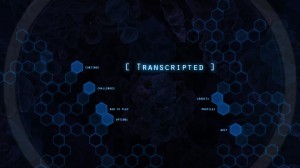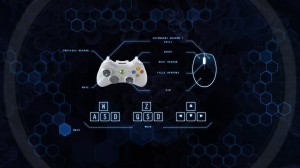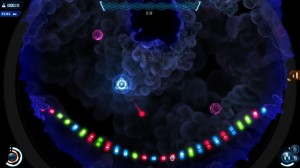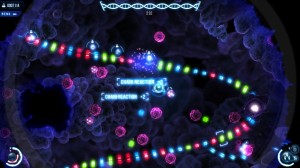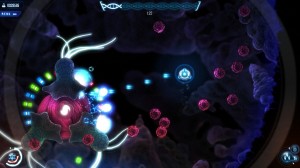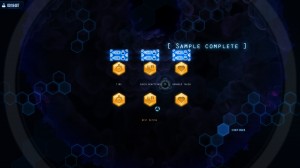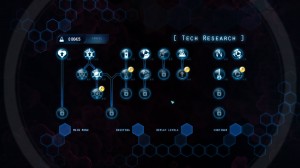Mankind is in danger once again (nothing new there), but this time, it’s not because an evil supervillain woke up on the wrong side of the bed and decided to blow up the San Andreas Fault for some quick cash. No, the aliens aren’t invading either…Will Smith, Jeff Goldblum, and Bill Pullman saw to that. This time, the enemy is much, much smaller and only Nano Probes can save the day.
Superman and Independence Day references aside, Transcripted is truly an interesting mix of puzzles and action…more specifically, it’s almost like mashing Zuma and Smash TV together but in a medical, microscopic setting. Still confused? Hang in there, I’ll explain. Before I do however, I’d like to quickly thank Bernd Wolffgramm from TopWare Interactive for sending me a free review copy.
Transcripted is a single player experience that puts the player in the role of Adam, a PhD student that has a speciality for software engineering and Galaga, apparently. With the help of NaDiA, an AI, you’ll be guiding a microscopic Nano Probe through a series of trials with the ultimate goal of defeating highly resilient pathogens. I won’t spoil specifics of the story, but suffice it to say, the Nano Probe is mankind’s last, best hope.
The look of the main menu was a breath of fresh air and certainly full of theme, reminding me a little of Deus Ex: Human Revolution. You’ll be able to switch profiles, start or continue the campaign, and participate in challenges. The controls aren’t rebindable, but they are simplistic enough that I didn’t need to perform surgery…no pun intended. While the game is advertised as a mix of dual stick shooter and puzzle game, I had no problems using just the mouse and keyboard.
The campaign starts you off slowly, showing you how to move your Nano Probe and how to shoot. I don’t own an XBox 360 controller, so I moved with the arrow keys and used the mouse to shoot where the cursor was pointed. The game introduces you to pathogens, which drop various things when destroyed. Some drop different colored cubes while others drop power ups that will aid you in your quest. As the game progresses, these pathogens, among other things, will shoot back and make your job that much harder.
So what kind of puzzles will you be facing? It depends on the level, honestly. The first few levels involved me shooting colored cubes a la Zuma to match three like colors together and make them disappear. You also get bonus points for making chains and making connections from far away.
As the levels progress, the chains of colored cubes move faster and the enemies become more ruthless. Not only will you be trying to pay attention to the colors in the chains, but you’ll also be trying to dodge enemy attacks and stay alive. Later on, you’ll actually be tasked with protecting these chains of pseudo-DNA from being destroyed by rogue pathogen cubes that fly towards it to make matches.
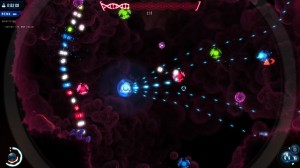
In later levels, you’ll actually need to stop the cubes from making chains…I found this to be very challenging.
Bosses also make an appearance, though they are varied in the way you fight them. One boss might be a huge behemoth that you have to whittle down systematically while another might be a hacking game. Hacking involves keeping your Nano Probe within the radius of a satellite so that a progress bar can completely fill up. You’ll see hacking outside of boss encounters and the process usually serves to reward the player in some fashion. Each boss is unique in that you’ll be trying to come up with different ways to adapt to the situation.
To help you out along the way are power ups. Some improve your weapon for that level, some allow you to fire without using energy, and some give you research points. Research points are acquired during the level and after, adding to a pool that changes as you earn and spend them. The game introduces you to a tech tree early on that you can plop points into for the cost of research points. The better you do, the more techs you can unlock to make your Nano Probe better. By that same token, the end of the level awards you with research points based on your performance. Players are encouraged to go back to prior levels to do better, earn points, and thus unlock more techs to make future levels easier.
The game’s challenge mode will help break things up when you need a break from the campaign. In short, it’s a survival mode that tasks you with staying alive and earning as many points as you can. The techs you unlocked in the campaign do not carry over, but there are different modes that define what you’ll have to work with.
I normally don’t play games like Transcripted, but I really had a good time of it. The graphics were beautiful and the colors were sharp. The music itself was soothing to listen to, that is, when I wasn’t fighting for my life. The game’s difficulty ramps up nicely and while some parts were difficult, I never became stuck on a level for longer than ten minutes…then again…I play my games on easy. I enjoy the experience and story of a game as opposed to banging my head off the wall, but that’s just me. Those of you seeking a challenge will definitely find it by choosing the harder difficulty modes. I also enjoyed the playful banter between the AI and Adam…there was definitely personality behind the voices.
Final verdict? It’s a great game, especially for when I want to unwind a bit and spend some time away from in-depth strategy games. Like any game, it may not be for everyone, but there’s a free demo on Steam. I’d recommend starting there to see if you like the game and if dropping ten bucks (as of 10/3/12) is warranted.
Final Verdict: 8/10
—
You can learn more about “Transcripted” by visiting the official website here:
http://transcripted.topware.com/en/index.html
—
You can find the game on Steam here:
http://store.steampowered.com/app/215450/
—
You can view play sessions here:
https://www.youtube.com/watch?v=vvMQpTUbxhU

